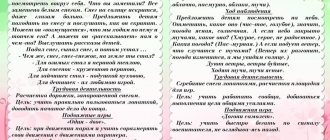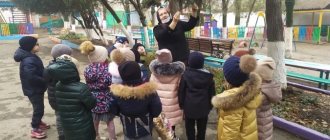Structure of outdoor leisure
The walking process is divided into several important components. These parts can be combined in different combinations, leaving unchanged only the fact that you need to complete the exercise with calm walking.
Observations
The basics of walking in the first junior group. Objects of consideration may include:
- plants, animals,
- precipitation,
- signs of changing seasons,
- human labor (as a janitor sweeps leaves, clears snow, etc.).
Depending on the object of observation there may be:
- short-term (forming ideas about the shape, color of certain objects, their position in space),
- long-term (for example, to demonstrate changes in leaf color depending on the season).
The algorithm for analyzing objects of observation is that children, together with an adult:
- establish facts (puddles appear after rain),
- connect them together (for example, there are a lot of puddles due to rain, the road is wet),
- accumulate similar information
- formulate a conclusion together with an adult.
Observing the signs of a particular season develops attentiveness and broadens your horizons
Labor activity
With the help of this work, the child develops a sense of responsibility.
- Putting toys in boxes or crates.
- Removing large debris and snow in winter (with shovels, brooms).
- Watering flowers. Usually kids are assigned to help carry the watering can or monitor the water level in it.
Any work should be feasible for kids
Game techniques
During walks with children 1.5–3 years old, there are 2 types of games: active and sedentary. Their choice depends on the theme of a particular walk and weather conditions. Active fun for good weather - tag, hide and seek, ball games, calm fun for slush - ring throw, construction set, etc.
The teacher participates in all proposed games, usually as a presenter
This is interesting. Psychologists have found that children of the first younger group, due to their age and maturity of the thinking apparatus, do not play together, but side by side.
Individual work
As a rule, all kids love to go for walks. Only the temperament of the guys can differ. Therefore, the teacher must find an approach to everyone: someone is playing with a ball, someone is jumping over a wheel. At the same time, there are children who at this time happily run after a beautiful dragonfly. The teacher’s task is to select an activity for each child and, after providing the necessary assistance (for example, showing how to hold a net correctly), monitor the correct execution.
This is interesting. A walk in the evening presupposes that the teacher will communicate with parents, which means observation, work - those types of activities that require maximum concentration of attention of not only children, but also adults, are not included.
Individual work also implies the opportunity to freely choose the type of activity
Video: individual play activity during a walk in the first junior group (spring)
Card file of walks in the younger group
The card files provide a description of walks for the entire school year, as well as for the summer period, when preschoolers spend most of their time in the preschool educational institution in the fresh air.
- Card index of walks for the first junior group (Alypova L.V., Torbostaeva E.N.).
- Card index of walks in the younger group (from 1–3 years old) (Ignatieva T.A.).
- Card index of walks in the younger group (Komarova N.V.).
Table: fragment of a card index of walks
| Subject | Kind of activity | Content | Tasks |
| Weather | Observation | Invite the children to see if there is sun or clouds in the sky. Ask what the clouds did (cover the sun), note what the sky is like (gloomy), what the weather is like (gloomy).
Draw the children’s attention to the treetops (swaying), the wind is blowing, the trees are swaying. The trees have colorful foliage.
| Learn to determine the time of year based on its characteristic features. |
| Labor activity | Water the sand for play. |
| |
| Outdoor games | "Sparrows and a car." Children - “sparrows” sit on a bench - “nests”. The teacher depicts a “car”. After the teacher’s words “Let’s fly, little sparrows, onto the path,” the children get up and run around the playground, waving their arms—“wings.” At the teacher’s signal, “The car is moving, fly, little sparrows, to your nests!” The “car” leaves the “garage”, the “sparrows” fly to their “nests” (sit on benches). The "car" returns to the "garage". |
| |
| “Take care of the item.” The players form a circle. One child is in the middle of the circle (leading), the rest stand with their legs slightly apart and holding their hands behind their backs. At the feet of each child lies a cube (or any other object). The driver tries to grab this cube, but the player protects it, crouches down and covers it with his hands, not allowing him to touch it. As soon as the driver leaves, the player stands up. A child who does not protect his cube takes a step back from the circle. He is temporarily out of the game. When the driver manages to take items from two or three players, a new driver is appointed. When the driver changes, the children standing behind the circle return to the game. |
| ||
| Individual work | Tasks for the development of movements. | ||
| Autumn | Cloud watching |
Invite the children to watch the clouds and tell them that clouds are made of water droplets. Invite each child to choose the cloud they like best and track where it is floating, moving quickly or slowly. Let each child give his cloud a name. |
|
| Labor activity | Collection of fallen leaves and other debris on the site. | Teach to maintain order in the kindergarten area. | |
| Outdoor games | "Sun and Rain." To the words “It’s raining!” run to your house (sit on a bench), and to the words “The sun is flying!” go to the middle of the site. |
| |
| "From bump to bump." On the playground, the teacher draws circles with a diameter of 30–35 cm, the distance between them is approximately 25–30 cm. These are hummocks along which you need to get to the other side of the swamp. You can step over the bumps, run across, jump over. |
| ||
| Individual work | Tasks for the development of movements. | ||
| How to behave on the road | Observation | Walk to the roadway and watch the traffic. Explain that the kindergarten is located next to the road. This is a highway.
Ask what cars are driving on the highway. Let the children name familiar cars. Pay attention to the fact that many cars and trucks are moving along the highway, and no one is interfering with each other. This is because drivers follow traffic rules. |
|
| Labor activity | Raking dry leaves to a specific place. | Learn how to use a rake correctly and fill buckets “to a certain level.” | |
| Outdoor games | "Sparrows and a car." |
| |
| "Catch-and-run." Children stand on one side of the playground beyond the line. A line is drawn on the opposite side of the site. There is a trap in the middle. After the words “One, two, three, catch!” children run to the other side of the playground, and the trap catches them. Anyone who is touched by the trap before the runner crosses the line is considered caught and moves aside. After 2–3 runs, those caught are counted and a new trap is selected. | Learn to coordinate your actions with the actions of your comrades. | ||
| Individual work | Games with dolls, cars. | ||
| Signs of spring | Observation | On a sunny March day, pay attention to the signs of spring: bright dazzling sun, high sky, light white clouds. On the south side, in the sun, the snow melts and icicles appear. The snow has become loose and wet - you can sculpt from it. Sparrows chirp happily and jump in the snow.
|
|
| Labor activity | Clearing paths from snow on the site, removing snow on the veranda. | Learn to shovel snow using shovels to a certain place. | |
| Outdoor games | "Hares". One of the players is chosen as a “wolf”, the rest are “hares”. At the beginning of the game, the “hares” stand in their houses, the wolf is on the opposite side. The “hares” come out of the houses, the teacher says: “The hares jump, hop, hop, hop, onto the green meadow. They pinch the grass, eat it, listen carefully to see if a wolf is coming.” Children jump and perform movements. After these words, the “wolf” comes out of the ravine and runs after the “hares”; they run away to their houses. The “wolf” takes the caught “hares” to his ravine. | Learn to quickly perform actions when given a signal by the teacher. | |
| “Jump and turn.” Children, freely positioned on the playground, jump in place at the count of “1, 2, 3”, and at the count of “4” they turn 45° to the right. Again they make 3 jumps in place, on the fourth they turn to the right. Returning to the starting position, children perform jumps to the left side. Between repetitions, you need to take a short break - walk around the site. | Strengthen push-off skills when jumping on two legs. | ||
| Individual work | Games based on interests. | ||
Table: example of a walk summary
| Author | Timofeeva Olga Vasilievna, teacher of preschool educational institution Anninsky kindergarten No. 7 |
| Name | Summary of a walk in the 1st junior group on the topic: “First spring flowers” |
| Kind of activity | Content |
| Observations |
Children approach a flowerbed where irises have bloomed. Educator: “Look how beautiful the flowers are. Do you know what they are called? These are irises. Pay attention to the leaves, what color they are.” Invites children to inhale the aroma of iris. The children move on and approach the tulips. Educator: “What are these flowers called? That's right, tulips. What color are these tulips? Find another flower like this. What color are the leaves?”
|
| Individual work | Walking on a limited surface (“Don’t step on the flower”). Children go out into a clearing with dandelions. Educator: “Look how many flowers have grown. These are dandelions. What are these flowers called? What color are they?"
The teacher suggests looking at the parts of the plant: stem, leaves, flower. Children walk through a clearing and see dandelions that have already bloomed.
Children examine a dandelion, blow on it, and watch the seeds scatter. |
| Outdoor games | "Bunnies."
|
"Dandelion".
| |
| Labor activity | Kids put away toys. |


